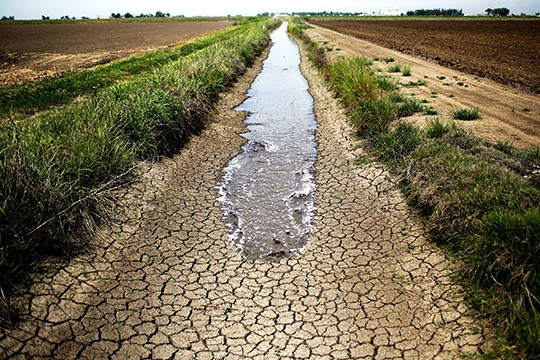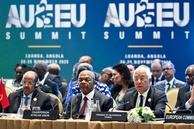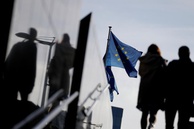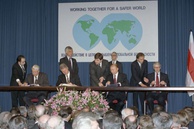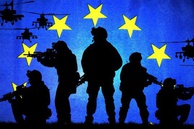According to media reports, the new EU Commissioner for the Environment, Jessika Roswall from Sweden, stated that the European Union needs to “urgently address the problem of water scarcity…”.
Water is indispensable; access to it is literally crucial for human survival and for agriculture. Water is a vital component in electric power generation, including at nuclear power plants, which are a relatively clean alternative to fossil fuels. Significant volumes of coal and fuel oil are transported by water. In case of a further increases in global average temperatures, the number of regions exposed to drought and acute water shortages will continue to grow.
Temperatures in Europe are rising faster than in other parts of the world. According to 2022 data cited by The Economist, the number of days with extremely hot weather in the Northern Hemisphere has increased sevenfold compared to the early 1980s. While streams of meltwater from mountain ranges are currently increasing in some parts of Europe due to accelerated ice melt, they are beginning to decrease in others. Meanwhile, this is crucial for the continent's water supply. Soils suffering from extreme temperatures during warm seasons do not retain rainwater sufficiently, leading to depletion of groundwater reserves. Extreme weather conditions in Europe are becoming more frequent: some regions experience increasingly frequent and deadly floods, while others face droughts.
Since 2000, the European Union has been trying to address water resource problems by implementing the Water Framework Directive (WFD), designed to ensure the volume and quality of European water. However, a report published last October by the European Environment Agency (EEA) shows that the problem of water shortages in Europe is worsening. [i] According to the report, water scarcity already affects a fifth of the EU's territory and nearly a third of its population annually. The report states that less than 40 percent of surface waters in the EU, such as rivers and lakes, can currently be considered clean. Almost 25 percent of groundwater is in unsatisfactory chemical condition, while providing almost two-thirds of drinking water.
Less than 30 percent of rivers, lakes, and coastal waters meet the pollution standards set by the WFD. The most significant damage to water resources comes from agriculture: agricultural pollution affects 32 percent of groundwater and 29 percent of surface water. Chemical pollution from coal power plants, as well as river modifications due to dam construction and straightening, also have a significant negative impact on surface waters. The report emphasizes the urgent need for a stricter enforcement of the Water Framework Directive and calls for substantial changes in agricultural production, reduction of water pollution and urgent restoration of ecosystems.
Droughts, leaking pipes, and overall policy inefficiency are the main factors contributing to the water scarcity problem on the continent, according to experts.
According to the World Meteorological Organization, the number and intensity of droughts in the EU have "increased dramatically": from 1976 to 2006, the area of territories affected by them grew by almost 20 percent. In recent decades, heatwaves have been hitting Europe more frequently, lasting longer, and covering a larger number of countries simultaneously. In the summer of 2018, the heat reached "anomalous" levels. Harvests of major crops in Germany, France, and Italy were the worst in a century. Droughts in Europe recurred in 2022 and 2023. Many media outlets described the 2023 situation as unprecedented "in the last five hundred years". That year, according to the European Commission's Joint Research Centre, up to two-thirds of the EU territory, as well as the UK, were in a critical situation in terms of water scarcity.
The drought continued into 2024. Wildfires yet again hit Greece, Spain, Portugal, Italy, and Sweden. Rivers shrank, significantly hindering navigation. From 2022-2024, the greatest damage was suffered by EU countries stretching from Portugal in the west to Hungary and Romania in the east, as well as all of Southern Europe. Farmers were most visibly affected, losing tens of percentage points of their harvests. The consequences of water deficit also caused increasing damage to many industries – from textiles to hydrogen production, a promising alternative to fossil fuels, which requires water for the electrolysis process.
Adaptation to regular extreme weather events is required across entire economic sectors and much of the housing stock. In central areas of large cities, temperatures can be 10-15 degrees higher than in the suburbs, as buildings and roads absorb and retain heat. Despite concerns about the growing strain on the industry, agriculture, and infrastructure, according to Commissioner Roswall, little has been done to improve the poor condition of water supply and sanitation systems in many EU countries. According to the European Commission, almost a quarter of treated water is lost during distribution. [ii]
In some countries, such as the Netherlands and Germany, losses have been reduced to less than 10 percent of the volume through maintenance expenditure. Bulgaria, Romania, and Italy lead the list of countries where, according to EurEau, the largest volume of tap water is lost. Soil hardened by drought can lead to the destruction and twisting of pipelines, exacerbating leaks. As water management is typically carried out by various local companies and municipalities, it is almost impossible for national and EU-level politicians to respond effectively to the crisis.
The European water pipeline network is enormous – more than 4 million kilometers of drinking water pipes. Pipelines run underground, making problem identification difficult. Even the growing number of pipes made from corrosion-resistant materials is not a panacea: vibrations from traffic in cities accelerate crack formation. Water utilities are increasingly turning to new technologies to monitor water consumption, detect leaks, and carry out repairs, including with the help of autonomous sensors, acoustic tools with AI components, and satellite imagery for leak detection. However, no single technology yet offers a perfect solution.
Traditionally, water tariffs for European households are lower than electricity bills, limiting the funds available for repairs. According to the OECD, all EU countries, except Germany, need to increase annual water spending by more than 25 percent to comply with EU drinking and wastewater rules, which means bills will rise. A separate report published in mid-October last year by the industry organization Water Europe states that €255 billion needs to be invested in Europe's water infrastructure over the next six years for EU countries to meet EU standards on water purity and supply.
The problem is not limited to the availability of water for drinking, cooking, washing, and growing crops. The much-promoted "green" technologies necessary for the EU to waive fossil fuels also require significant water consumption. The Energy Transition Commission stated that by 2050, the volume of water for electricity generation, hydrogen electrolysis, nuclear power plant cooling, and carbon capture could reach 58 billion cubic meters per year – this is approximately double the current drinking water consumption in Europe. The extraction of raw materials needed for electric vehicles and wind turbines could increase this figure by another 4-5 billion cubic meters per year, according to the report.[iii] Furthermore, the network of data centers, which use large amounts of water for cooling and humidification systems, is constantly expanding, as is the demand for high-tech semiconductor production, which requires "ultrapure" water for chip rinsing.
Last summer, environment ministers from 21 of the 27 EU member states appealed to the European Commission amid water supply problems, urging it to take "specific measures" to improve the security and resilience of water resources. This followed heightened tensions over access to water, particularly in countries such as Italy, Greece, and Spain. In several regions of Spain, residents faced water consumption restrictions, justified by authorities as necessary to preserve supplies for tourists and farmers. In July and August, as the emergency situation in the Mediterranean worsened, some areas of Greece and Italy also introduced strict daily water rationing.
Since 1999, the European Commission has launched over 500 cases against member states for violating water usage rules. In September 2024, European Commission President Ursula von der Leyen announced an initiative to improve the sustainability of water resources, but it was subsequently postponed due to farmer protests. Von der Leyen later promised to develop a European Water Sustainability Strategy during the Commission's next mandate, which began in December. A list of measures intended to "...ensure proper management of water sources and address water scarcity" is expected to be presented at the beginning of the new year.
Since agriculture remains the main consumer of water resources, there is an urgent need to change agricultural practices to reduce pollution and adapt agriculture to lower water consumption. However, this issue is extremely politically "sensitive" for many member states. The water resource problem remains a source of acute discontent among agricultural producers, whose large-scale protests in recent years regularly paralyze the life of European capitals and increasingly lead to open clashes with environmentalists. Meanwhile, increasing water deficits could also lead to increased spending on fighting fires, droughts, and floods. According to the EEA, droughts and fires in 2022 alone caused €40 billion in damage across the EU, and the European Commission's Joint Research Centre predicts that direct damage from floods will likely increase sixfold by 2100.
Most European observers believe that the situation regarding water resource availability in Europe will only worsen. Despite the general understanding of the urgency and relevance of the issue, EU environmental legislation is one of the most contentious issues among member states, industry representatives, and the agricultural sector. Water management and regulation are extremely bureaucratic, and the powers and responsibilities of administrative bodies at various levels are blurred. To solve the accumulated problems, the EU needs measures that are both expensive and unpopular with voters. Even Commissioner Roswall avoided the direct answer regarding the prospects for increased water charges for EU citizens, pointing out that the bloc needs to "…search for new innovative ways of financing" the development of pipeline and purification systems.
The author's opinion may not coincide with the Editorial stance.
[i] https://www.eea.europa.eu/en/analysis/publications/europes-state-of-water-2024
[ii] https://www.ft.com/content/6960192a-8de1-4050-94ca-f6c36186b8c3
[iii] https://www.ft.com/content/80122ded-4158-45f9-915c-a52b5fb2d088
read more in our Telegram-channel https://t.me/The_International_Affairs

 11:41 14.01.2025 •
11:41 14.01.2025 •
